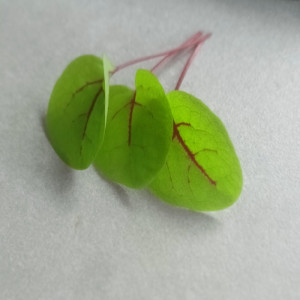Microgreens-Starter package-12X10-BZ080840
EAN code: 8711117808404
Contents: 12 types x 10 bags
Dimensions in cm: 55x48x25


Sigurnosno Plaćanje preko vaše Banke - Montegreenery Powered

.jpg)


The cart is empty

First, if you are looking for international information or, for example, if you are looking for sorrel seeds in a foreign online store:
Latin name: Rumex sanguineus
English name: Wood Dock or Redveined Sorrel
German name: Blut-Ampfer
French name: Oseille sanguine
The name sorrel is a general name for a small number of different species within this plant species.
Depending on where you want to sow/plant sorrel and what you want to use it for, you choose the type. There is also field sorrel, marsh sorrel, sheep sorrel, horse sorrel, blood sorrel and more. Some species are even considered weeds and are therefore very common. The best types of sorrel to eat are the Polish sorrel (Rumex acetosa, the best known and most widespread sorrel), the Spanish sorrel (Rumex scutatus), the spinach sorrel (also called seven-year spinach or everlasting spinach, Rumexpaticia), and this blood sorrel.
Rumex sanguineus (bloodwort) is a winter-hardy perennial plant. I myself have a Rumex sanguineus Bloody Dock (but that addition is obviously not a variety name but good for selling, I think ? . Because I don't see the difference with the species.
I always think it is very beautiful, the leaf is so special; bright green with bright red leaf veins. This sorrel has a weaker taste than the Polish one, but the appearance makes up for it. I must say that the young leaves are the most beautiful color, as the leaves get older they become a bit pale green, and the red veins become brownish-red. In other words: harvest a lot and ensure that new leaves are born.
The common sorrel, Rumex acetosa, is obviously much more acidic than this slightly acidic sorrel. If you really want to grow and harvest sorrel for stewing, cooking, making soup, etc., choose sorrel. I find this sorrel particularly tasty and beautiful in salads, as an edible garnish, etc. The taste is like lettuce, but with a bit of lemony acidity, especially in veins.
The leaves contain a lot of vitamin C. I like to watch programs like Masterchef on TV and sometimes I see young leaves of Blood Sorrel in high-end restaurants, they are easily recognized by their bright green leaves with equally bright but red veins.
Alexandra's exotic garden
Facebook Twitter Instagram
BLITVA - RED VEIN
Read more
A plant
As mentioned earlier, sorrel is a winter-hardy perennial: it grows to about 30 centimeters in height, and the plant will also flower from the second year after sowing. These flowers are borne on spikes about 50 centimeters high and are insignificant (think a little of the flower spikes of beets, for example, but much thinner and thinner and brownish in color).
The tastiest are the young leaves (delicate structure and soft and fresh and with a nice, slightly sour taste). Older leaves not only become less beautiful, but also somewhat firmer in structure and less fresh in taste. So pick and eat the young leaves, for example in a salad. You can still use older leaves for stewing.
Sorrel is known to contain a lot of oxalic acid (as well as rhubarb). Eat the leaves whenever you want, but watch out for large amounts. Certainly not everyone suffers from it, but there are people who are sensitive to it and can suffer from stomach/intestinal problems with higher amounts, and too much oxalic acid is bad for the bile and kidneys (maybe something to be aware of when you have guests for example , kidney disease).
That doesn't sound pleasant, but I assure you that a few leaves in a tasty salad a few times a week is not a problem.
Read more
SOIL / FERTILIZER
Since bloodwort is a plant whose leaves you pick and eat, a normal basic fertilizer, organic or otherwise, is sufficient. As a perennial plant, it fits perfectly into a beautiful vegetable garden, edible ornamental garden, herb garden, etc.
In the spring we work in some old manure and/or compost. This provides better soil structure and enough humus, allowing the roots to grow better and providing better drainage. And we plant the seedlings in a planting hole, to which we first add a layer of potting soil.
Sorrel (no nothing to do with the name) likes to grow in slightly acidic soils. It also does well in clay here, but in any case it always gets rainwater instead of tap water, so we never give the plants lime.
Read More
SOWING AND PLANTING
I have grown it several times blood sausage from seeds and it's very easy. I sowed the seeds in March at room temperature, in potting soil that I slightly aerated with a little sand for crushing. The seeds will then germinate within 2 weeks. I also sowed the seeds in a tray in a greenhouse in March (see picture above), germination takes a week longer, but that works well too. If you want to sow the seeds outside, it is better to wait until April.
Seedlings can be planted outside from mid-April, when they are big enough. My experience is that the plants do better in partial shade than in the sun (the leaves are fresher and more beautiful, they bloom less quickly, etc.). Of course, water young and newly planted seedlings regularly until they have enough roots to take care of themselves.
Once the plants are big enough, you can pick some leaves from time to time. The youngest
EAN code: 8711117808404
Contents: 12 types x 10 bags
Dimensions in cm: 55x48x25
Portulak ili Tušt je zeleno, lisnato povrće koje se može jesti sirovo ili kuvano. Naučno je poznat kao Portulaca oleracea, a naziva se i svinjac, mala svinja, debeljuškast i pusley. Ova sočna biljka sadrži oko 93% vode. Ima crvene stabljike i male, zelene listove.
EAN-code : 8717202605187
Get started right away with growing fresh sprouts with this complete sprout seed package. In addition to the seeds for the various sprouts, the sprouting tray is also included. So you can get started right away.
Consumer advice:
EAN code:8711117873808
Contents: 16 pieces
Dimensions in cm: 20x5.5x5.5
Position: Sun/partial shade
Seed type: Open-pollinated variety
Seed weight (indication): 50 seeds per gram
Plant distance: 20x8 cm
Plant height: 20-40 cm
EAN code: 8717202600052
Bag size: 125x153 mm
Bag contents: 8 grams (for min. 5 m2)
EAN code: 8711117808404
Contents: 12 types x 10 bags
Dimensions in cm: 55x48x25
Position: Sun/partial shade
Seed type: Open-pollinated variety
Seed weight (indication): 55 seeds per gram
Plant distance: 30x5 cm
Plant height: 50-70 cm
Bee plant: attracts bees
EAN code: 8717202601301
Bag size: 75x123 mm
Bag contents: 6 grams (for min. 3 m2)

The cart is empty


